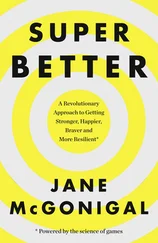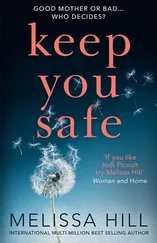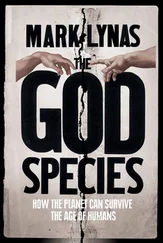Each geological period is named for one of these rocky layers. They’re chunks of frozen time, identified by their unique combinations of life-forms and mineral deposits. Generally, fossils change dramatically from layer to layer because there has been an extinction event. Though only five of these demarcations qualify as mass extinctions, there have been dozens of smaller extinction events where, say, 20 or 30 percent of all species die out. You might say that geological time is measured in extinctions. But if you were to visit Dover, and allowed your eyes to wander up the cliff face, you’d also see layer after layer of evidence that life always emerges from mass death.
The more we learn about these layers, the more it seems that there are two basic causes that can set a mass extinction in motion. The first is an unexpected calamity from the inanimate physical world, often taking the form of fatal climate patterns, megavolcanoes, or even debris from explosions in space. As for the second, as we learned in the last chapter from the cyanobacteria that poisoned the planet, biological life can transform the physical world so much that extinctions are inevitable. Of course, many extinctions are a combination of the two causes—one often leads to the other.
To see examples of both, we’ll journey back hundreds of millions of years to the first two mass extinctions that gripped the Earth. The Ordovician (beginning roughly 490 million years ago) and Devonian (beginning roughly 415 million years ago) were both periods when life was exploding with unprecedented diversity. And both ended in holocausts. The Ordovician was scourged by natural disasters from Earth and space; the Devonian was choked to death by invasive species that turned the planet into an environmental monoculture.
The Ordovician Period (490 Million–445 Million Years Ago): How the Appalachians Destroyed the World
Before the fecund Ordovician period, the seas had stopped looking like goo-covered murk and flowered into underwater forests full of aquatic plants, shellfish, coral, and lobsterlike arthropods called trilobites. New species were evolving at a rapid clip. It was a greenhouse world, with carbon dioxide levels in the air at fifteen times higher than they are today. But a warm, high-carbon climate was exactly what those Ordovician plants and animals needed.
Peter M. Sheehan, a geologist with the Milwaukee Public Museum, describes the Ordovician as having “the largest tropical shelf area in Earth’s history.” Put another way, it was a world of sultry beaches. Earth blossomed into this tropical paradise partly due to the climate, and partly due to continental drift, the process by which massive plates of the Earth’s crust slowly move around on top of the planet’s superheated molten layers. Lava gushing from underwater volcanoes applied so much pressure to the Earth’s crust that it pushed all the continents together, into the low latitudes of the warm southern hemisphere. Slowly drifting over the South Pole was a supercontinent called Gondwana, made up of land that became, among other places, Africa, South America, and Australia. Its balmy, world-wrapping coastline teemed with life.
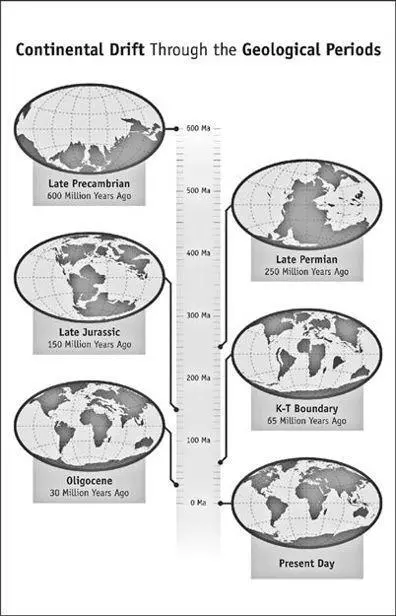
Maps of the continents during different geological eras. (illustration credit ill.2)
(Click here to see a larger image.)
Ordovician life was confined almost entirely to the oceans, though a few plants spread to the land. Trilobites scuttled into many different territories, evolving into a range of species: some became swimmers, while others wandered the floors of the shallow seas, developing sharp, defensive spines or shovel-shaped heads for rooting food out of the sediment. Shelled creatures and sea stars attached themselves to enormous coral reefs, and strange colony animals called graptolites built complicated, beehive-like structures out of proteins secreted from their bodies. Their hives, which looked like thorny, interconnected tubes, floated beneath the ocean surface while the graptolites poked their feathery heads out and snarfed up plankton.
The ancestors of sharks prowled the waters and fed on everything that moved (and some things that didn’t). Joining the sharks were jawless fish called agnathans, whose soft mouth slits and heads were covered in bony plates that probably looked like turtle shells. These armored fish were the first vertebrates, or animals with internal skeletons like we have. Plus, there were thousands of new kinds of plankton evolving all the time, creating an abundant food source for all the multicelled newcomers looking for easy-to-reach food floating through the waters.
But over a few hundred thousand years, over 80 percent of the species in the Ordovician coastal waters would go extinct.
We can place part of the blame for the slaughter on the Appalachian Mountains, a gently curving spine of peaks that stretched from Canada’s Newfoundland down to Alabama in the southern United States. These mountains were formed during the Ordovician when a smashup between two continental plates pushed ancient volcanic rock into jagged peaks above the continent. Almost immediately, rain and wind began eroding the soft, dark rock. The newly formed mountains ran with thick slurries of water and mud, which turned into rivers that picked up even more soil on their way to the seas. This natural process, called weathering, is actually one of the most powerful ways to change our planet’s atmosphere. As exposed earth crumbles beneath the weather’s onslaught, tiny rocks pull carbon dioxide from the air and take it with them into sediments deep beneath the sea. Sliding into the sea along with all that carbon was the Ordovician’s warm, life-nourishing climate.
Seth Young, a geology research associate at Indiana University, observed, “We are seeing a mechanism that changed a greenhouse state to an icehouse state, and it’s linked to the weathering of these unique volcanic rocks.” The Ordovician Appalachians weathered so rapidly, in fact, that they were worn down to a flat plain within a few hundred million years. The Appalachians we know today are the result of a second tectonic-plate smashup, which raised a new set of mountains about 65 million years ago. Washing carbon out of the atmosphere sounds like a good dream in our fossil-fueled times, but it was the worst thing that could happen in the Ordovician. Without greenhouse gases to keep the planet warm, disaster struck in the form of the fastest glaciation in the planet’s history. About 450 million years ago, ice caps began to spread outward from the poles. Gondwana and its hot, humid shorelines were at ground zero of the ice apocalypse.
As the glaciers grew, they locked up liquid water and lowered sea levels dramatically, drying out the lush coastal areas beloved by corals, graptolites, and shelled creatures. Most affected were stationary animals like the shellfish in a coral reef, which remain anchored in place for most of their lives. Because they couldn’t move, they died with their habitats. In all, Peter Sheehan estimates that about 85 percent of marine species died over a million years as massive ice sheets sucked the liquid out of their environments. Not all the Ordovician species died at once. There were two “extinction pulses,” as geologists put it. The first came when ice abruptly destroyed sea life. The second came when the ice melted just as suddenly as it had come, causing sea currents to slow and stagnate. Fewer currents meant that less oxygen was churned into the water and vast “dead zones” of anoxic (low-oxygen) water suffocated life throughout the oceans. First came ice, then came stagnation. Together, they created a mass extinction.
Читать дальше
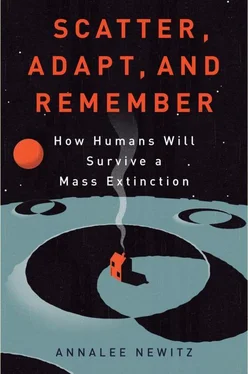






![Аннали Ньюиц - Автономность [litres]](/books/424681/annali-nyuic-avtonomnost-litres-thumb.webp)


